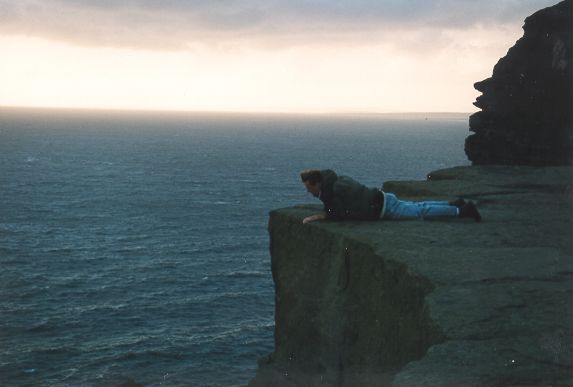but never committed.”
~ Lou Holtz (football coach)

Recent events have people talking about the heroism of teachers who stepped up to defend their students. People pose and posture and say “if I had been there” and suggest they would have done something to stop the rampage. The real truth is that until you find yourself in such a situation and on the threshold of commitment, you really don’t know what you’ll do.
There’s a story in our family lore about the time dad stopped a convenience store robbery. At the time, he was building a new house for his family; working his regular job, and then framing walls until the sun went down. To finish a long day he would often drive (wearily) to a 7-Eleven for some fast food and coffee. It was on one of these nights, while stirring milk into a paper cup, that he made a snap decision to commit. Looking back his decision had potentially catastrophic results.
You’re probably familiar with the normal, bland atmosphere of a convenience store: flat fluorescent lighting, racks of packaged goods, a few customers waiting in line to buy bread and milk. That night the scene shifted in an instant as two guys began hassling the clerk. It was unclear why, but the intensity level shifted immediately as the two grabbed the clerk by the hair and began hauling him over the counter. It was then, as he glanced around at the few other customers still shocked and immobile, that dad completed a simple internal dialogue: I guess it’s up to me.
Simple. In the chaos of the moment, absolute clarity. Somehow, in a flash moment, he realized he could change the outcome in a positive way. After a brief scuffle, he and the clerk were able to wrestle the assailants out the doors, lock them, and call the cops. His description of that moment, the moment of decision, has become somewhat of a personal mantra: I guess it’s up to me.
In later years I found myself the first on the scene of a car crash, instructing an injured person to remain still and calm, having already called for first responders and told another passerby to direct traffic. Another time I found myself driving a co-worker to the hospital, his hand bandaged and the finger he had lost in my lunchbox cooler. The specifics leading up to my point of commitment are lost in the chaos, but my subsequent actions flowed from the decision to get personally involved: I guess it’s up to me.
It’s hard to say if such judgement is learned behavior or innate. Dad didn’t talk about it much, but his time in the Army probably gave him a bias for action those other customers didn’t have. With the incident over and the clerk bleeding from several cuts, those customers were still in line. One even asked “can we pay for these now?” Every time we drove by that place we called it “the fight 7-Eleven”. Even decades later and the place now a homemade candy shop, we still call it “the fight 7-Eleven”. The landmark is forever colored by the incident. We always ask ourselves why our father acted and the others just stood there.
We are all faced with situations every day where we must commit. Do I take this gap in traffic? Do I order the chicken or the beef? Do I ask this person to marry me? Do I say yes? Making decisions is part of life. Making good decisions is called judgement. People with naturally good judgement are said to have “common sense”. Good judgement and common sense are not reserved for the lucky few. Judgement can be developed and enhanced – preparation to face the commitment threshold. Preparation makes it easier to assume a leadership role, having already faced the commitment threshold. Properly prepared, you can cross it without a second conscious thought.
Consider these techniques to get past the commitment threshold:
Burn your ships. Legend has it Spanish Conquistador Hernán Cortés landed his 508 soldiers, 100 sailors and 16 horses in southern Mexico and then burned his ships. From that point the Spanish unable to retreat, faced between 5 and 6 million adversaries and were fighting every minute for their lives. In two years they had conquered the Aztecs. While many things contributed to their eventual victory, there was no question about commitment.
Make it public.When you commit to something in public, you instantly build an accountability committee. Somewhat less dramatic but still effective is to write down your commitment, shown by this study to influence a successful outcome.
Reward decisions. The act of deciding something is a behavior. You need to reward it. You must of course celebrate and reward the outcomes of your decisions, but you must absolutely reward the decision itself.
So seek out situations where you bring yourself closer to the commitment threshold. Burn your ships to force action. Discover what public commitment feels like. Reward the act of commitment itself. The time to decide whether you will help stop a convenience store robbery is not when you’re watching the robbery unfold. The time to decide is now. It’s up to you.
Here’s another perspective on commitment. Check out this fun three-minute video and learn some “Leadership Lessons from Dancing Guy” (YouTube link).
